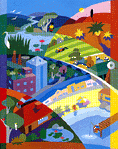
On Holiday and On the Water


On Holiday and On the Water

| Rock, Reef, Rainforest Australia was one of the first countries in the world to ratify the World Heritage Convention in 1974. There are no less than 13 areas in Australia on the World Heritage List, the most famous of which are: How to protect biodiversity on holiday In and On the Water The seas are a staggering variety of life, covering three quarters of the surface of the earth and plunging to a depth of 11 kilometres. Australia has responsibility for 11 million square kilometres of oceans, containing some of the richest biodiversity in the world. However, over-fishing and pollution is turning this rich soup into a watery wasteland. One of the hardest hit is the Southern Bluefin Tuna. After decades of unsustainable harvesting the breeding stock of the tuna is a mere 10 per cent of what it once was. At our shorelines lives a wealth of biodiversity. These animals and plants have adapted to the impact of pounding waves and can survive regardless of whether they are submerged or not. However, they cannot withstand over-harvesting . Shellfish have been taken for food or bait, literally stripping many of the more popular rock platforms. Freshwater environments are particularly special because many species are restricted to just one or two river systems. The Black Grunter Fish, for example, is found only in the Prince Regent and Roe Rivers which flow into the Timor Sea. If these rivers were substantially altered, the Black Grunter could become extinct. Most fish need free flowing rivers with natural changes in depth, temperature and salinity over the seasons in order to live and reproduce. Recreational fishing, agriculture, irrigation and urban development have altered many of our rivers and depleted fish stock. Rivers are suffering from over extraction of water, increasing salinity, nutrients and chemicals, artificial dams, removal of riverside vegetation and introduction of exotic species. These changes have left native fish species struggling to survive. This section of my environment web site is based upon a booklet produced by the Department of the Environment and Heritage, Environment Australia. This material can be freely reproduced for non-commercial purposes provided Environment Australia is acknowledged. Their logo appears at the bottom of this page. |
Now take a tour of my Biodiversity Web.
![]() 20 Ways to Protect Biodiversity
20 Ways to Protect Biodiversity
![]() In the Backyard and Beyond
In the Backyard and Beyond
![]() Food, Health, Farms
Food, Health, Farms
![]() Warning: Signs of Change
Warning: Signs of Change
![]() Links and Resources
Links and Resources
![]() Biodiversity Home Page
Biodiversity Home Page
![]() Back to the Environment Site Map
Back to the Environment Site Map
![]() E-mail me
E-mail me
Biodiversity material from:
